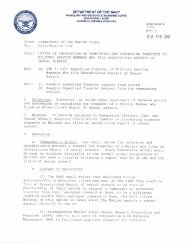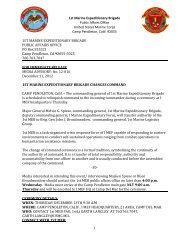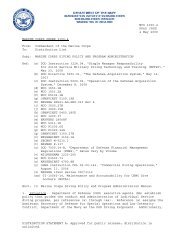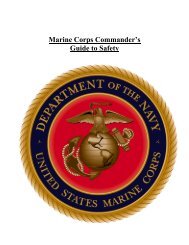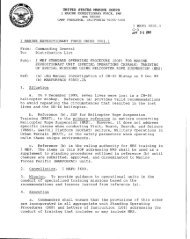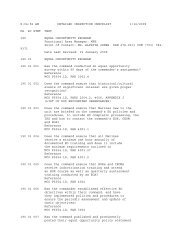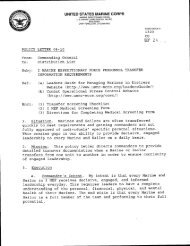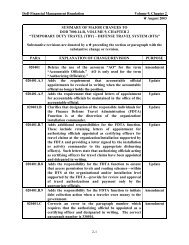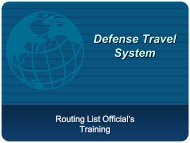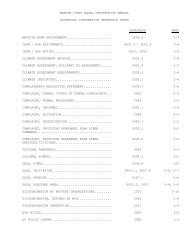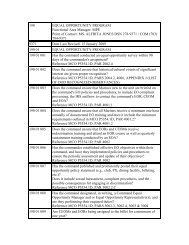personnel qualification standard (pqs) - I Marine Expeditionary ...
personnel qualification standard (pqs) - I Marine Expeditionary ...
personnel qualification standard (pqs) - I Marine Expeditionary ...
Create successful ePaper yourself
Turn your PDF publications into a flip-book with our unique Google optimized e-Paper software.
112 USMC Operations<br />
HA force or a peace operations force. Many peace operations include HA<br />
considerations, even when not expressed in the peace operation mandate and<br />
mission. HA-type missions that could occur in conjunction with peace operations<br />
include:<br />
o Providing food, potable water, shelter, transportation, and engineer<br />
support to the resident population.<br />
o Assisting in the delivery of humanitarian aid, especially to isolated<br />
communities.<br />
o Providing emergency medical treatment and medical assistance programs<br />
for the prevention of disease.<br />
o Providing extraction and evacuation of sick, injured, or wounded civilians.<br />
HA is an important MOOTW mission that the US military is uniquely qualified to<br />
plan and execute. Unlike any other single organization, the military has the<br />
organizational structure, educated and trained <strong>personnel</strong>, essential equipment,<br />
rapid worldwide deployability, and ability to operate in austere physical<br />
environments.<br />
Examples of MOOTW range from domestic support to combat operations. They<br />
include JTF Andrew, Operation Desert Shield, Operation Urgent Fury, and<br />
Operation Provide Comfort. MOOTW include a wide range of operations<br />
occurring in both domestic and foreign environments, which include both combat<br />
and noncombat operations. HA employs military assets to support noncombat<br />
objectives as part of MOOTW. Since MOOTW normally occur to support the<br />
political/diplomatic instrument, the military may not be in the lead. This<br />
highlights the criticality of interagency and NGO and PVO cooperation and<br />
coordination for mission success.<br />
112.5 Define the acronym MOUT.<br />
Importance of Urban Areas.<br />
Military operations on urbanized terrain (MOUT) is defined as all military actions<br />
planned and conducted on a topographical complex and its adjacent terrain<br />
where manmade construction is the dominant feature. It includes combat in cities,<br />
which is that portion of MOUT involving house-to-house and street-by-street<br />
fighting in towns and cities<br />
Throughout history, military planners have viewed cities as centers of gravity. As<br />
such, in war, cities are something to be either protected or taken away, depending<br />
upon one’s perspective (MCDP 1, Warfighting). Cities house the population<br />
centers, transportation hubs, seats of government, sources of wealth, centers for<br />
industry, information networks, and key nodes of communication within a nation.<br />
Recent forecasts based on population statistics and the worldwide migration trend<br />
from agrarian to industrialized societies predict that 85 percent of the world’s<br />
population will reside in urbanized areas by the year 2025. As the world trend<br />
toward urbanization increases, the military significance of cities is likely to<br />
increase proportionally.<br />
112-6



